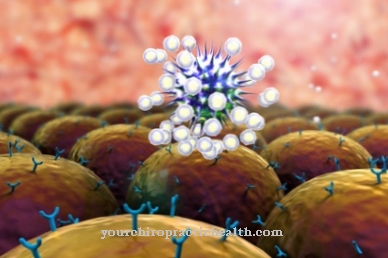The neural plasticity spans various restructuring processes of the nerve cells, which are an essential condition for learning experiences. The reconstruction of synapses and synapse connections will take place until the end of life and take place depending on the use of individual structures. In neurodegenerative diseases, the brain loses its neural plasticity.
What is neural plasticity?

Nerve cell tissue has a certain structure. This structure is also known as the neural structure and is subject to permanent restructuring processes. The development of the brain is completed in early childhood, but the nerve tissue has not yet reached its final structure by then. In any case, a final structure of the brain never exists. The brain in particular is characterized by its high ability to learn.
This ability to learn is largely due to the ability and readiness of the nervous tissue to remodel. The remodeling processes are also known as neural plasticity and can affect a single nerve cell as well as entire areas of the brain. Restructuring in the sense of neural plasticity takes place depending on the specific use of certain nerve cells.
Individual areas of neuronal plasticity are intrinsic and synaptic plasticity. In the context of intrinsic plasticity, nerve cells can adapt their sensitivity to the signals from neighboring nerve cells. Synaptic plasticity, on the other hand, refers to the connections between individual nerve cells. The neurons (nerve cells) form a network of individual connections with one another. A connection in the memory corresponds, for example, to a memory content. Thanks to the synaptic plasticity, unusable connections can be broken again and new synapse connections can be created.
Function & task
The central nervous system is one of the most complex regions in the entire body. Until a few decades ago, the prevailing assumption was that the neural structure of the brain is static from birth and has completed its development. That would mean that the brain does not change any further until death. On the basis of research, however, neuroanatomy and neurology have discovered the complex learning processes of the brain that significantly change the structures of nerve cells and last for a lifetime.
Immediately after birth, infants have 100 billion individual nerve cells. A healthy adult does not have many more individual cells. However, an infant's neurons are still small and have few connections. After birth, the individual cells begin to differentiate and mature. It is only at this time that the first synaptic connections between the nerve cells are established.
The neural plasticity corresponds to the unrelenting processes of connecting and breaking connections. The intensity of these remodeling processes depends on the age. Many regions of the brain, for example, slow down their adaptability with the years of life. A basic ability to be rebuilt remains, however, until death.
Neural plasticity is the essential condition for learning processes of all kinds and also contributes to memory performance. The life path of the individual decides which areas of the brain are particularly stressed. The synaptic connections are then most extensive in these areas. The brain of a musician shows strong connections in other areas than the brain of a doctor.
Memory and knowledge are also to be understood as synaptic connections. Depending on how often these connections are used, the nervous system is rebuilt. The synaptic links between memory and knowledge are more likely to be retained, for example, if the respective thoughts or memories are frequently called into consciousness. The brain works more efficiently and only retains connections that are known to be needed. Less frequently used connections give way and give way to new connections with higher relevance.
You can find your medication here
➔ Medicines against memory disorders and forgetfulnessIllnesses & ailments
The neural plasticity has nothing to do with the ability to regenerate. The nervous tissue of the central nervous system is highly specialized. The more specialized tissue types are, the less capable of regeneration they are. For this reason, the brain can recover from injuries much less well than skin and tissue during wound healing.
In childhood, brain injuries can be compensated far better than after the end of the development phase. If nerve tissue within the brain dies due to an insufficient supply of oxygen, a traumatic injury or an inflammation, this nerve tissue can no longer be replaced. Under certain circumstances, however, the brain can relearn and compensate for the deficits caused by the injury. In stroke patients, for example, it was observed that the fully functional nerve cells in the immediate vicinity of the dead ones take over the tasks of the damaged brain areas This assumption of functions from other areas of the brain primarily requires targeted training. Due to these relationships, walking-impaired people were documented again after a stroke, for example.
The fact that such successes have been observed has in the broadest sense to do with the neuronal plasticity of the brain. Dead nerve tissue no longer has neuronal plasticity and cannot regain it. Nevertheless, the neural plasticity in the intact areas of the brain is retained.
The loss of neural plasticity can be seen particularly in patients with degenerative brain diseases. In these brain diseases, the nerve cells in the brain break down piece by piece. Such a degradation necessarily goes hand in hand with the loss of neural plasticity and thus also the loss of the ability to learn.
In addition to Alzheimer's, Huntigton's disease and Parkinson's are among the best-known brain diseases with degenerative consequences. In contrast to stroke patients, the transfer of individual functions to neighboring areas of the brain in connection with neurodegenerative diseases is not easily possible.













.jpg)

.jpg)
.jpg)











.jpg)